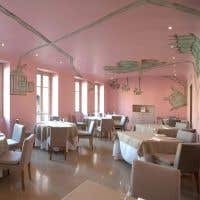This article was also published in the Financial Times.
I was standing on the terrace of Palas Cerequio, once a series of farm buildings, today a small, elegant hotel on the outskirts of La Morra in the province of Barolo in Piedmont, northern Italy. My view in every direction was of one of the crops that make this region so appealing.
make this region so appealing.
Vines spread out on all sides as alongside me, Pio Boffa, who makes the renowned Pio Cesare wines, explained various particular sites. As he did so, he confessed that he loves his food as much as his wine, and our conversation soon moved on to this region’s other annual crop, currently invisible as they snuggle up underground – a crop far more expensive than any Barolo wine.
Pio was relishing the prospect of the next harvest of white truffles in October/November and, with his long perspective on such treats, he explained their growing significance.
’The winemaker and the truffle hunter don’t actually want the same from Nature as the more rain there is the better the truffle harvest, but the more difficult the wine vintage. And as 2013 has been the wettest spring for 45 years, an excellent truffle vintage should be some compensation,’ he concluded with a relish.
Boffa also recalled a time when interest in white truffles was not so universal. Fifty years ago it was principally Germans and Swiss who would drive down in the autumn, he recalled, but now demand is truly international.
And this one unique ingredient has over the past 15 years has had a very particular effect on the region’s restaurants. The prospect of cooking with white truffles and satisfying the customers lured here by their very particular heady, earthy and expensively illusive aromas has in turn attracted many more talented chefs. There are, Boffa concluded with great pride, far more excellent restaurants in his vicinity than ever before.
But great food does not necessarily require expensive ingredients as was evinced by our first dinner, cooked by Gian Piero Vivalda now in charge of Antica Corona Reale, a long-established restaurant in Cervere near Bra.
In fact the delight in his menu came from the flavours Vivalda cleverly extracted from all the accompanying ingredients. There was the verdant puree of chard with the slices of roast quail; the unusual combination of rice and diced cabbage inside golden ravioli, obviously made with an inordinate amount of egg yolks; and, best of all, a thin pressed cake of potatoes from the small, mountainous village of Entracque with the succulent veal shank. When I asked the waiter for the recipe all that I could decipher was that it was a laborious process that magically encompasses nothing other than two simple ingredients: these highly regarded potatoes and lots of butter.
Potatoes proved to be the unlikely connection between this meal and a dinner at Piazza Duomo restaurant in the centre of Alba, a dinner that was as remarkable for its originality as for its location.
This small restaurant, whose single bright pink dining room has only eight tables, is located on the first floor of a building that until 2005 had been three apartments. Since then it has been the home to chef Enrico Crippa (see photographs below) who, unlike most top chefs finishes his dishes from a ‘pass’ half way down the kitchen rather than by the exit to the restaurant as is the norm, while his cooks go out on to the balcony for the odd piece of equipment where the former residents once hung their washing.

I can report on this unusual set up, and the absolute precision of Crippa’s immaculate kitchen, because we occupied a table for two that occasionally is squeezed into his tiny office with glass walls on three sides. (The fourth wall is an amalgam of photos, sample plates, and copies of that other great, pink newspaper, Lo Gazzetto Dello Sport). The views to the right of the two-man pastry section and to the left where 10 other chefs weave around each other were totally absorbing although I could not imagine how the extra three chefs Crippa recruits during the truffle season manage to squeeze in.
This vantage point allowed us to watch the multiple plates of small dishes that emanate from chefs like Crippa with such culinary ambition. And while a couple tipped their hat to El Bulli, most incorporated inexpensive ingredients such as marinated turnips, small artichokes and diced porcini mushrooms grown in Crippa’s garden and enhanced by a plethora of colourful herbs and flowers, the consequence of Crippa’s three years cooking in Japan.
An exciting menu led us to four fascinating dishes. There was the potato connection in a creamy potato soup with a quail’s egg marinated in lapsang souchang (in winter this comes with the odd slice of white truffle); an ‘egg and egg salad’ incorporating lettuce leaves topped with grated, marinated egg yolks and the eggs of Italian caviar and bottarga, mullet roe; a pink risotto, finished with chopped flowers and prawns; and a combination of prawns and cherries whose colours would have delighted any artist. We drank a 2009 Arbarei, made from Riesling grapes by Ceretto in the Alta Langhe for 35 euros, from a wine list carefully compiled by Mauro Mattei.
I waited until Crippa had put the finishing touches to two main course plates before passing on my compliments about his kitchen’s creativity. He smiled modestly before adding, ‘Grazie, but it still all depends on me being the first in here every morning and the last to leave.’
Palas Cerequio, www.palascerequio.com
Antica Corona Reale, www.anticacoronareale.com
Piazza Duomo, www.piazzaduomoalba.it
Da Felicin, excellent restaurant with rooms, Montforte d’Alba, www.felicin.it

